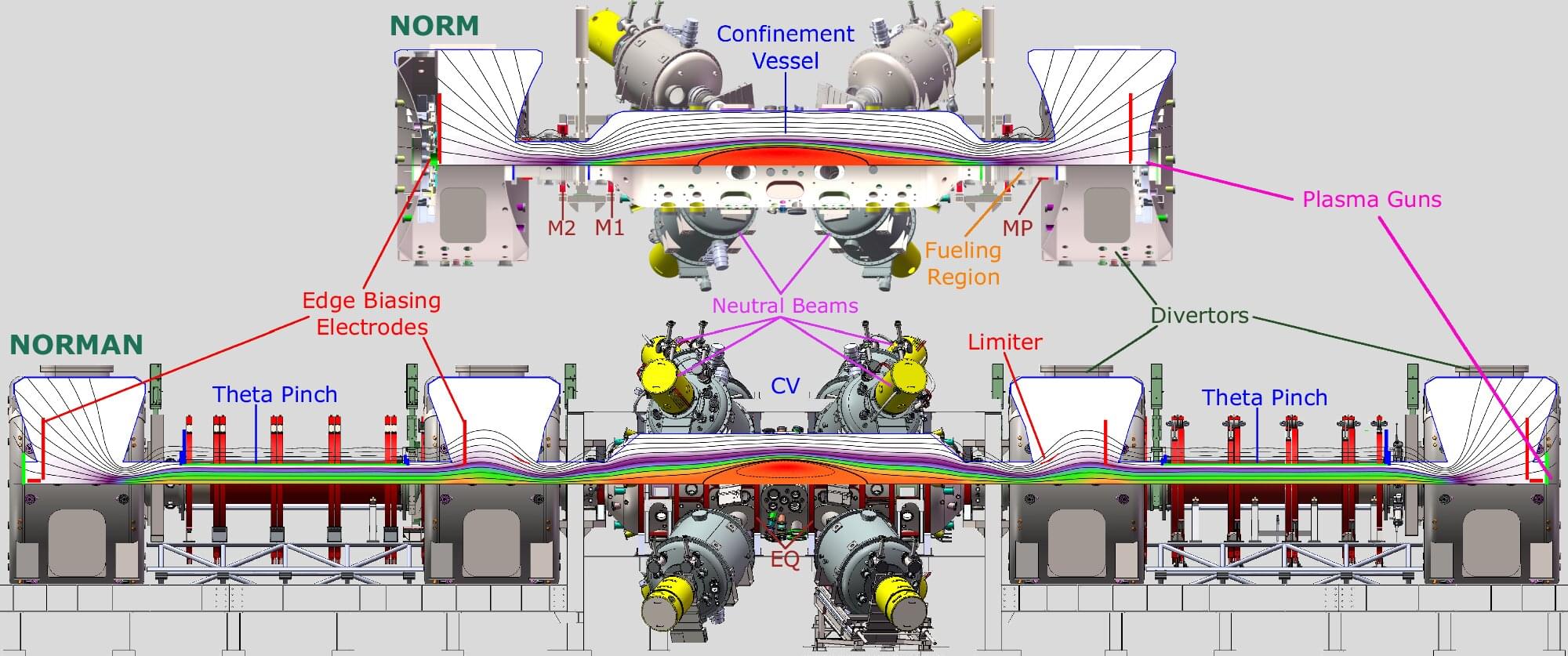In the shadow of the wrecked nuclear power plant in Fukushima, Japan, a new research centre is seeking to revitalize the region.




In a critical fusion breakthrough, scientists from the international ITER nuclear fusion energy project have announced the completion of the sixth and final component of the reactor’s central solenoid, a magnet powerful enough to levitate an aircraft carrier.
Described as a “landmark achievement” by the 30-country ITER collaboration, the pulsed superconducting electromagnet and other completed components will be assembled at the group’s designated site in southern France.
“By integrating all the systems needed for fusion at industrial scale, ITER is serving as a massive, complex research laboratory for its 30-plus member countries, providing the knowledge and data needed to optimize commercial fusion power,” the group explained in a statement announcing the achievement.

In a landmark achievement for fusion energy, ITER has completed all components for the world’s largest, most powerful pulsed superconducting electromagnet system.
ITER is an international collaboration of more than 30 countries to demonstrate the viability of fusion—the power of the sun and stars—as an abundant, safe, carbon-free energy source for the planet.
The final component was the sixth module of the Central Solenoid, built and tested in the United States. When it is assembled at the ITER site in Southern France, the Central Solenoid will be the system’s most powerful magnet, strong enough to lift an aircraft carrier.

Lightweight lithium metal is a heavy-hitting critical mineral, serving as the key ingredient in the rechargeable batteries that power phones, laptops, electric vehicles and more. As ubiquitous as lithium is in modern technology, extracting the metal is complex and expensive. A new method, developed by researchers at Penn State and recently granted patent rights, enables high-efficiency lithium extraction—in minutes, not hours—using low temperatures and simple water-based leaching.
“Lithium powers the technologies that define our modern lives—from smartphones to electric vehicles—and has applications in grid energy storage, ceramics, glass, lubricants, and even medical and nuclear technologies,” said Mohammad Rezaee, the Centennial Career Development Professor in Mining Engineering at Penn State, who led the team that published their approach in Chemical Engineering Journal.
“But its extraction must also be environmentally responsible. Our research shows that we can extract lithium, and other critical minerals, more efficiently while drastically reducing energy use, greenhouse gas emissions and waste that’s difficult to manage or dispose of.”
*Apply to join Foresight Intelligent Cooperation program:* https://foresight.org/intelligent-cooperation/
A group of scientists, engineers, and entrepreneurs in computer science, ML, cryptocommerce, and related fields who leverage those technologies to improve voluntary cooperation across humans, and ultimately AIs.
*Maarten Boudry | Will Humanity Be Subjugated by Superintelligent AIs?*
Abstract: Some people are worried that if we ever create superintelligent AIs, they might turn against us—trying to subjugate humanity, wrest control, and grab resources, much like living creatures shaped by evolution. Dan Hendrycks from the Center for AI Safety has argued that AI systems are already undergoing a form of natural selection, facing ruthless market competition in the current AI race. Will this endow them with the instinctive drives for self-preservation and dominance typical of evolved creatures? In this talk, I push back against this evolutionary doom scenario, using the framework of “Darwinian spaces” by Peter Godfrey-Smith. A better analogy for AI evolution might be the domestication of animals. Just as humans have bred dogs to be friendly and obedient, we might shape AIs in similar ways, selecting for desirable traits like helpfulness and non-aggression. Even in a highly competitive AI race, AIs are unlikely to become selfish or power-hungry. That said, we do agree with the AI doomers on one point: if we allow AIs to “go feral” and be subjected to truly blind evolution—like wild animals competing in nature—that could become very dangerous.
Bio: Dr. Maarten Boudry is a philosopher of science and first holder of the Etienne Vermeersch Chair of Critical Thinking at Ghent University. He published over 50 academic papers and two edited volumes: Science Unlimited? (2018) and Philosophy of Pseudoscience (2013). He wrote six trade books in Dutch on science and philosophy, the latest one being The Betrayal of Enlightenment (Het verraad aan de verlichting, 2025). He’s also a Roots of Progress fellow and a regular contributor to Quillette, The Conversation, The Independent and Human Progress. Substack for English writings: maartenboudry.substack.com.
Bio: Simon Friederich is an associate professor of philosophy of science at the University of Groningen, the Netherlands. He is currently focused on the philosophy of quantum theory, trying to solve the quantum measurement problem along the lines envisioned by Einstein before advanced AI makes his efforts redundant. He has also worked on the philosophy of technology, notably on nuclear energy, sustainability, and advanced AI. His thoughts on these topics have been featured in German and Dutch media. With his wife and five kids he lives in a village in the North of the Netherlands.
*Speaker Link*
https://maartenboudry.substack.com/
*Timecodes*


As the world races to build the first commercial nuclear fusion plant, engineers from the University of Surrey have made a breakthrough in understanding how welded components behave inside the extreme conditions of a reactor—offering critical insights for designing safer and longer-lasting fusion energy systems.
Working in collaboration with the UK Atomic Energy Authority (UKAEA), the National Physical Laboratory, and global supplier of scientific instruments for nanoengineering TESCAN, researchers have developed and used an advanced microscopic method to map hidden weaknesses locked inside welded metals during manufacturing that can compromise reactor components and reduce their lifespan.
The research, published in the Journal of Materials Research and Technology, details how they examined P91 steel—a very strong and heat-resistant metal candidate for future fusion plants. Researchers applied an advanced imaging technique using a plasma-focused ion beam and digital image correlation (PFIB-DIC) to map residual stress in ultra-narrow weld zones that were previously too small to study with conventional methods.

Found in everything from kitchen appliances to sustainable energy infrastructure, stainless steels are used extensively due to their excellent corrosion (rusting) resistance. They’re an important material in many industries, including manufacturing, transportation, oil and gas, nuclear power and chemical processing.
However, stainless steels can undergo a process called sensitization when subjected to a certain range of high temperatures—like during welding—and this substantially deteriorates their corrosion resistance. Left unchecked, corrosion can lead to cracking and structural failure.
“This is a major problem for stainless steels,” says Kumar Sridharan, a professor of nuclear engineering and engineering physics and materials science and engineering at the University of Wisconsin–Madison. “When stainless steel gets corroded, components need to be replaced or remediated. This is an expensive process and causes extended downtime in industry.”

A team of fusion researchers at TAE Technologies, Inc., in the U.S., working with colleagues from the University of California, has developed a new type of fusion technology that the company claims produces 100 times the power of other designs while costing just half as much to run. Their study is published in the journal Nature Communications.
Over the past several decades, scientists around the world have been trying to find a way to produce electricity using fusion reactors. Despite recent advancements, commercial electricity produced by fusion reaction power plants is still likely years away, due mainly to inefficiencies and cost. The team working in California claims that they have made significant inroads into solving both problems.
Their work was focused mostly on improving the field-reversed configuration (FRC), a magnetic confinement technique. As the researchers note, generating fusion reactions involves first generating plasma, which has to be contained. Because it is so hot, it cannot simply be contained; instead, it is held in place by a magnetic field.